RETRACTED: Meta-analysis of minimally invasive arthroscopy with sodium hyaluronate for wound healing of knee osteoarthritis treatment in the elderly
Abstract
Knee osteoarthritis (KOA) is not merely a medical condition—it is a prevalent and incapacitating ailment that significantly affects the quality of life for millions worldwide, especially as they age. The incidence of KOA increases year by year with increasing age. This study evaluated the therapeutic efficacy of combining arthroscopy with sodium hyaluronate (SH) in the treatment of wound healing of knee osteoarthritis (KOA) in elderly patients, with a focus on wound healing and overall joint function restoration. Randomized controlled trials (RCTs) evaluating the combination of arthroscopy and SH in geriatric KOA patients were identified through a systematic search of the scientific literature utilizing multiple databases and predefined search criteria. Ultimately, twelve investigations were included in the meta-analysis. Using Stata 15.1 software, data extraction and analysis were conducted using both fixed- and random-effects models, and a sensitivity analysis was conducted to assure the validity of the findings. Compared with arthroscopy alone, the combination of arthroscopy and SH significantly improved the efficiency rate, pain management (as measured by the Visual Analogue Scale), knee function (as measured by the Lysholm Knee Scoring Scale) and decreased levels of the pro-inflammatory cytokines IL-1 and IL-6. The meta-analysis revealed minimal heterogeneity between studies, and the sensitivity analysis validated the results' reliability. The incorporation of SH into arthroscopic procedures for elderly patients with KOA provides significant therapeutic benefits, including improved wound healing, reduced inflammation and enhanced joint function overall. These results support the use of this combined approach in the management of KOA in the elderly population and emphasize the need for additional research to optimize treatment protocols and comprehend long-term outcomes.
1 INTRODUCTION
Knee osteoarthritis is significant challenge in geriatric medicine, manifested as a degenerative disorder of the musculoskeletal system and frequently referred to as proliferative or senile arthritis.1 The incidence of KOA increases with age, with a significant increase every 2 years.2 A comprehensive systematic review reveals that the overall prevalence of KOA in China is 18%, rising to 39.9% in the middle-aged and elderly demographics and to 60.1% in community-dwelling individuals over 60 years old.3, 4 The aetiology of KOA involves the spectrum of pathological changes, such as the degeneration of local articular cartilage, subchondral bone remodelling and alterations in synovium, capsule and contiguous tissues. The culmination of these alterations is knee pain, swelling, deformity and functional impairment.5 In its most severe form, KOA can cause disability, thereby imposing substantial physical and financial burdens on patients.6
Arthroscopic debridement has become a prevalent intervention due to its minimally invasive nature, rapid procedure time, notable therapeutic results and decreased incidence of postoperative complications. This method is particularly useful in the early to middle stages of KOA management. Lavage of joint cavity during arthroscopy is crucial because it facilitates dilution and elimination of various inflammatory mediators, thereby reducing pain and inflammation. Consequently, arthroscopic debridement is notable not only for its clinical benefits but also for its cost effectiveness.4
Sodium hyaluronate is the naturally occurring glycosaminoglycan synthesized by cartilage and synovial cells, is a derivative of hyaluronic acid.5 It is found ubiquitously in the synovial fluid and cartilage of the knee and other synovial joints, where its viscoelastic properties play a crucial role in modulating joint tension and preserving homeostasis.6 Nevertheless, the progression of KOA is characterized by a progressive depletion of this biological matrix within the joint space, resulting in a decrease in the concentration and average molecular weight of hyaluronic acid in the synovial fluid. This depletion is a precursor to the deterioration of articular cartilage.7
In light of these considerations, this meta-analysis was rigorously evaluated the therapeutic efficacy of combining arthroscopy with SH treating KOA in elderly, with the focus on wound healing and overall joint function restoration.
2 MATERIALS AND METHODS
2.1 Literature search
Two researchers independently conducted the systematic literature search, adhering to predefined inclusion and exclusion criteria and managed the identified studies using NoteExpress software. The initial screening consisted of examining titles and abstracts, followed by a full-text evaluation to finalize study inclusion and extract pertinent data. The extraction of data was organized methodically in an Excel spreadsheet. In cases of disagreement, third researcher was consulted so that a consensus could be reached through discussion.
2.2 Study criteria
This meta-analysis included all RCTs that investigated the efficacy of arthroscopy combined with SH in treating elderly patients with KOA, regardless of publication status or language.
2.3 Selection of participants
The study population consisted of elderly patients diagnosed with KOA, excluding those with the recent history of arthroscopy or SH therapy.
2.4 Intervention protocol
The experimental group received arthroscopy in conjunction with SH, while the control group received arthroscopy alone. Among the exclusion criteria for study selection were: Nonrandomized controlled trials; studies not reporting on the combined intervention of arthroscopy and SH; studies lacking original data or with incomplete datasets; studies with inconsistent outcome measures or statistical methodologies. Five literature or animal investigations.
2.5 Outcome measures
A comprehensive evaluation of clinical trials from major databases and academic journals identified the commonly used outcome measures for assessing KOA in elderly as follows: 1 score on Visual Analogue Scale (VAS); 2 score on Lysholm scale; 3 levels of interleukin-1 (IL-1); 4 levels of interleukin-6 (IL-6); and 5 efficiency rate.
2.6 Search strategy
A comprehensive search of databases, including PubMed, Embase, Cochrane Library, Web of Science, CNKI, VIP, WanFang and CBM Libraries, was conducted to identify all relevant RCTs published through March 2022. The search in English databases made use of free-text terms including ‘Arthroscopy’, ‘Knee Osteoarthritis’ and ‘Sodium Hyaluronate’
2.7 Statistical analysis
Stata 15.1 software was used to conduct the meta-analysis. Continuous outcomes were expressed as mean difference (MD) with the 95% confidence interval (CI), while binary outcomes were expressed as relative risk (RR). I2 was used to evaluate the heterogeneity of study's results. If I2 was less than 50%, fixed-effects model (FE) was used for analysis, whereas the random-effects model (RE) was employed if I2 was greater than 50%. A sensitivity analysis was conducted to identify potential sources of heterogeneity and evaluate the validity of the meta-analysis's findings.
3 RESULTS
A systematic search of multiple databases yielded 237 references in total. After removing duplicates, the titles and abstracts of 107 articles were evaluated for a preliminary screening. This resulted in the selection of sixteen full-text articles for detailed analysis. Four studies were subsequently excluded due to data inconsistencies (n = 3) and lack of randomization (n = 1). The PRISMA flowchart illustrated the selection process for studies (Figure 1).
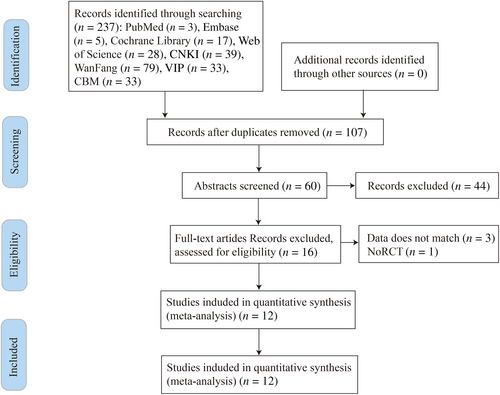
In eight studies comparing the test group (arthroscopy combined with SH) with the control group (arthroscopy alone), the baseline characteristics of studies on knee osteoarthritis (KO) treated with sodium hyaluronate (SH) revealed sample sizes, gender distributions, mean ages of both treatment and control groups, disease durations, main outcomes (VAS score, Lysholm score, IL-1, IL-6, efficiency rate) and treatment durations in weeks. Sample sizes, age groups and study durations varied with outcome measures including clinical scores and inflammatory markers. Treatment periods ranged from 4 to 10 weeks (Table 1). The efficacy rate (the percentage of elderly patients with KOA who demonstrated substantial improvement in pain reduction and joint function) was reported. The meta-analysis revealed that the test group had a substantially higher rate of efficiency (p < 0.01) (Figure 2). A funnel plot was used to assess and illustrate publication bias (Figure 3). The trials exhibited low heterogeneity, and a sensitivity analysis was performed to confirm the validity of the findings (Figure 4). In conclusion, the combination of arthroscopy and SH significantly increased the efficacy rate in elderly KOA patients compared to arthroscopy alone.
| Study | Sample size (T/C) | M/F | Age (years) (Mean ± SD) (T/C) | Duration (year) (Mean ± SD) (T/C) | T | C | Main outcomes | Treatment (week) |
|---|---|---|---|---|---|---|---|---|
| Xu, 2020 | 54/54 | 75/33 | 72.0 ± 5.3/72.7 ± 5.4 | 5.4 ± 3.0/5.4 ± 2.8 | KO + SH | KO | ①、②、③ | 4 |
| Chen, 2020 | 49/49 | 54/44 | 66.15 ± 4.26/66.27 ± 4.18 | 1.23 ± 0.41/1.30 ± 0.32 | KO + SH | KO | ①、② | 10 |
| Xu, 2016 | 44/36 | 47/33 | 75.7 ± 11.3/74.4 ± 12.2 | 8.3 ± 1.1/7.5 ± 1.3 | KO + SH | KO | ②、③、⑤ | 5 |
| Wang, 2017 | 48/48 | 53/43 | 65.6 ± 5.3/67.1 ± 6.3 | 9.0 ± 1.3/9.1 ± 1.2 | KO + SH | KO | ③、③、④、⑤ | 4 |
| Jiang, 2018 | 18/18 | 23/13 | 66.3 ± 5.1/66.7 ± 5.3 | 9.2 ± 1.2/9.3 ± 1.1 | KO + SH | KO | ②、③、④、⑤ | 4 |
| Wang, 2019 | 55/55 | 60/50 | 68.48 ± 2.58/69.12 ± 2.63 | 6.12 ± 1.15/6.22 ± 1.09 | KO + SH | KO | ③、③、④ | 4 |
| Li, 2019 | 65/65 | 57/73 | 65.38 ± 2.43/66.42 ± 2.85 | NA | KO + SH | KO | ①、②、⑤ | 4 |
| Bu, 2018 | 30/30 | 34/26 | 75.69 ± 11.45/75.12 ± 11.18 | 1.57 ± 0.84/1.55 ± 0.85 | KO + SH | KO | ①、④、⑤ | 5 |
| Han, 2018 | 42/42 | 46/38 | 66.58 ± 3.1/67.52 ± 3.4 | 6.98 ± 0.8/7.74 ± 1.2 | KO + SH | KO | ①、②、④ | 4 |
| Hu, 2014 | 135/135 | 94/176 | 69 ± 8/70 ± 8 | NA | KO + SH | KO | ②、④、⑤ | 4 |
| Xu, 2019 | 50/50 | 46/54 | 65.3 ± 5.6/64.3 ± 5.1 | NA | KO + SH | KO | ①、②、④、⑤ | 4 |
| Li, 2016 | 43/43 | 53/43 | 70.3 ± 4.1/70.6 ± 4.4 | 1.15 ± 0.26/1.18 ± 0.25 | KO + SH | KO | ①、②、⑤ | 5 |
- Abbreviations: ①, VAS score; ②, Lysholm score; ③, IL-1; ④, IL-6; ⑤, Efficiency rate; KO, Knee Osteoarthritis; SH, Sodium Hyaluronate.

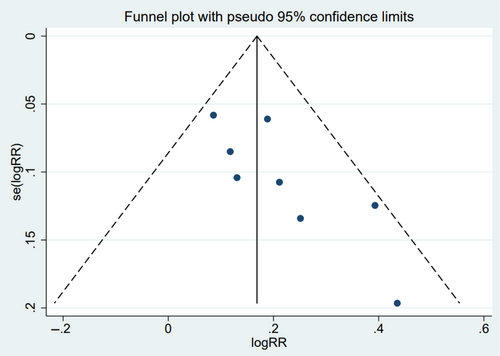
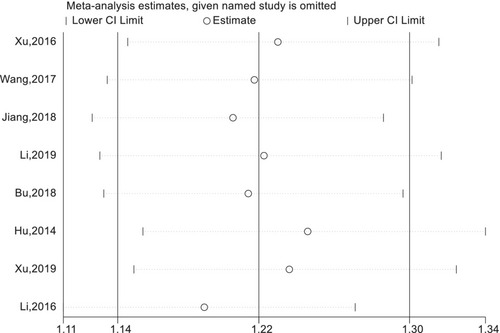
Seven studies reported pain assessment VAS scores. The meta-analysis revealed a significant reduction in VAS scores in the test group compared with the control group (p < 0.01; Figure 5), indicating improved pain management.

Eleven studies reported the Lysholm score, which evaluates knee function and symptoms. Compared with the control group, the test group demonstrated a significant increase in Lysholm score (p < 0.01; Figure 6).
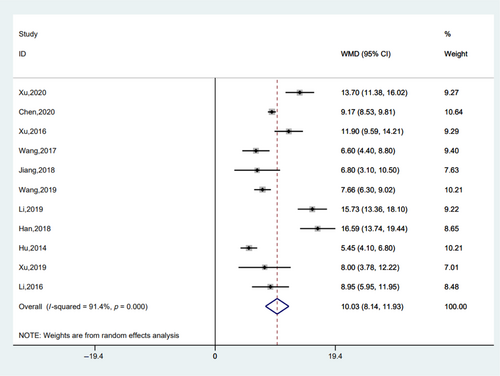
Five investigations measured the levels of the pro-inflammatory cytokine IL-1. Compared with the control group, the test group demonstrated a significant decrease in IL-1 levels (p < 0.01; Figure 7), indicating a superior anti-inflammatory response.

Five studies also reported IL-6 levels, an additional inflammatory marker. Compared with the control group, the test group had substantially lower IL-6 levels (p < 0.01; Figure 8), indicating a more pronounced anti-inflammatory effect.
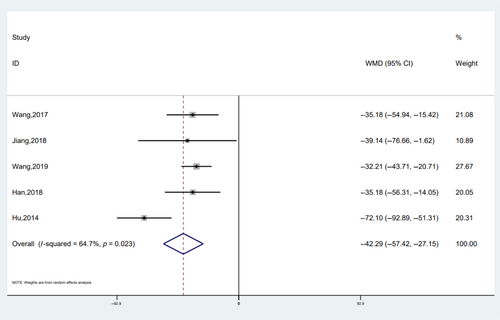
According to the results of this meta-analysis, the combination of arthroscopy and SH demonstrated superior efficacy in improving efficiency rate, pain management, knee function and diminishing inflammatory markers in elderly patients with KOA.
4 DISCUSSION
This meta-analysis compared efficacy of arthroscopy plus sodium hyaluronate in treating knee osteoarthritis in elderly patients versus arthroscopy alone. The outcomes demonstrated distinct advantage of combined intervention, with improvements in efficiency rate, pain management, knee functionality and inflammatory marker reduction.
4.1 Comparative effectiveness and pain treatment
Adding SH to arthroscopic procedures has a substantial therapeutic benefit, as evidenced by the substantially higher efficiency rate in the test group. This is supported by the significant decrease in VAS scores, which indicates effective pain management. SH, which is known for its viscoelastic properties, likely contributes to enhanced joint function and pain relief by lubricating and cushioning the joint.8 These findings are consistent with previous research and emphasize the beneficial effects of SH in the management of KOA symptoms.8, 9
4.2 Functional enhancement and inflammation decrease
The improvement in Lysholm scores provides additional evidence of the combined treatment's efficacy, indicating improved knee function and symptom relief. Moreover, the significant decrease in pro-inflammatory cytokines IL-1 and IL-6 suggests a potent anti-inflammatory effect, which is essential given the inflammatory nature of KOA. These results demonstrate the potential for SH to modulate the inflammatory response and improve joint health.10
4.3 Therapeutic synergy and action mechanisms
The combination of arthroscopy and sodium hyaluronate appears to have a synergistic effect, thereby improving the therapeutic outcomes for elderly patients with KOA.11 Arthroscopy alone provides a mechanical intervention, removing detritus from the joint and addressing structural issues. When combined with SH, a biological component is introduced that provides lubrication, absorbs stress and may stimulate endogenous hyaluronic acid production. The molecular mechanisms underlying these beneficial effects warrant further investigation, as a better understanding of these pathways could lead to the development of more targeted therapies and optimized treatment protocols.12
4.4 Patient-centred results
Not only do the observed improvements in efficiency rate, VAS and Lysholm scores reflect clinical efficacy, but they also likely translate into significant improvements in patient quality of life. Maintaining joint mobility and independence is of utmost importance for the geriatric population. The reduction in knee pain and improvement in knee function observed in this study may contribute to increased independence, social engagement and overall life satisfaction.13 Future research should consider incorporating patient-reported outcome measures to capture these dimensions and provide a more comprehensive assessment of treatment efficacy.
4.5 Effects on inflammation and joint health
Significant reductions in the pro-inflammatory cytokines IL-1 and IL-6 indicate that the combined treatment has anti-inflammatory properties. Chronic inflammation plays a crucial role in the progression of knee osteoarthritis, making anti-inflammatory therapies invaluable. The findings suggest that the addition of SH to arthroscopic procedures may aid to preserve joint integrity, potentially slowing the progression of KOA-related degeneration.14
4.6 Clinical practice and healthcare utilization implications
The implications of this study's findings for clinical practice are substantial, particularly in the context of an ageing population. As the prevalence of KOA continues to rise, there is an urgent need for clinically applicable treatment strategies that are effective. The combined treatment strategy evaluated in this study is a viable option that has the potential to increase patient outcomes and care efficiency.15 In addition, by enhancing patient functionality and decreasing pain, there may be subsequent reductions in healthcare utilization, such as fewer visits to healthcare providers and a reduced need for pharmacological interventions.
4.7 The effect of sodium hyaluronate on treatment response
The observed variation in response to SH across studies raises concerns about the factors that influence treatment efficacy. Patient characteristics, such as the severity of knee osteoarthritis (KOA), baseline hyaluronic acid levels and individual variations in inflammatory profiles, may modulate the response to SH. Deeper investigation of these factors could help to identify subgroups of patients who are more likely to benefit from the combined treatment, thereby paving the way for personalized medicine approaches to the management of KOA.15
4.8 Innovation and prospective therapeutic methods
The favourable outcomes associated with the combination of arthroscopy and SH highlight the potential of innovative treatment strategies in the management of degenerative joint diseases.16 Future research could investigate the incorporation of other therapeutic agents with arthroscopy, potentially identifying novel combinations with even greater benefits. In addition, investigating the optimal timing, dosage and administration methodologies of SH in conjunction with arthroscopy could further refine the treatment strategy and improve therapeutic outcomes.
4.9 Perspectives on global health and accessibility
From a global health perspective, it is essential to ensure access to efficacious KOA treatments. In low-resource contexts, the combination of arthroscopy and SH may present financial and logistical challenges. Strategies to increase the accessibility of this treatment approach, such as the development of cost-effective SH formulations or streamlined arthroscopy procedures, could have a substantial impact on the global management of KOA.13
4.10 Comprehensive approach to elderly care and KOA administration
Lastly, the management of KOA in the elderly requires a holistic approach that takes into account the disease's multifaceted nature and the unique challenges confronted by this population. The combination of physical therapy, lifestyle modifications and psychosocial support with innovative medical interventions such as the combined arthroscopy and SH treatment could provide a comprehensive strategy that addresses both the physical and psychological aspects of KOA. Encouragement of active participation and self-management could further empower elderly patients, leading to enhanced outcomes and quality of life.17, 18
Similar findings were reported by the researchers that by incorporating psychological support and physical therapy, as well as advanced medical treatments and arthroscopy used in conjunction synergistically, to treat KOA effectively.19, 20
4.11 Limitations
This study has certain limitations. First, 12 RCTs included 1288 patients. The overall sample size is not very large, and all RCTs were single-centred.
5 CONCLUSION
This meta-analysis supports the efficacy of combining minimally invasive arthroscopy with sodium hyaluronate for the treatment of knee osteoarthritis in the elderly, demonstrating significant improvements in efficacy rates, pain relief and joint functionality, as well as a significant reduction in pro-inflammatory cytokines. These findings highlight the potential for this integrative approach to improve clinical outcomes, advocate for its incorporation into standard KOA management practices and highlight the need for further research to optimize treatment protocols and comprehend long-term effects.
FUNDING INFORMATION
No funding was received for this study.
CONFLICT OF INTEREST STATEMENT
The authors declare that they have no conflicts of interest.
Open Research
DATA AVAILABILITY STATEMENT
The data used to support this study are available with the corresponding author.


